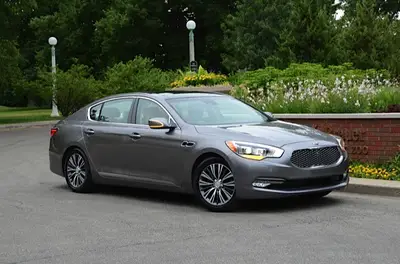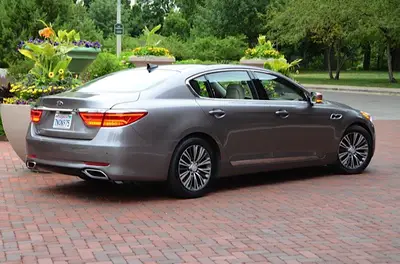We recently reported on
Kia’s success in the 2016 JD Power Initial Quality Study (IQS), the USA car industry’s benchmark for new-vehicle quality. The South Korean company was number one. While the result will have surprised many it is anything but a surprise to those of us that have been watching the steady rise of the giant Hyundai/
Kia group.
We’ve just spent a week in the latest version of the
Kia Optima, released late last year, and quality is the word that immediately sprung to mind. This isn’t just a good Korean car, it’s one that stands comparison with many much more expensive cars from either Japan or Europe.
Styling
New Optima is the first
Kia to be developed under the full control of Peter Schreyer, President and Chief Design Officer of Kia Motors.
"The interior has that luxury feel and ambiance that we except from much more expensive cars."
It features edge surfaces, sharp body lines and creases, and a more elongated sedan silhouette. The GT variant that we tested has a bold, purposeful, look with an aggressive front bumper design; black high gloss side sills; a rear air diffuser with integrated dual tailpipes and GT badging.
Engines / Transmissions
The Optima range has been trimmed back to two variants: the $34,490 Si with the carryover 2.4-litre naturally-aspirated four-cylinder 138kW, 241Nm engine. The $43,990 GT is powered by a new all-alloy 2.0-litreturbocharged petrol motor. Boasting 180kW and 350Nm, the latter features a twin-scroll turbocharger and dual continuously variable valve timing technology.
Both engines drive the front wheels through
Kia’s own design of six-speed automatic transmission with paddle shifters. Both also come with three drive modes: Normal, Sports and Eco.
The Optima rolls on either 17-inch (Si) or 18-inch (GT) alloy wheels with Continental rubber on Si and performance-rated Michelin Pilot Sport 3 for the GT. Both carry a full-size spare.
Interior
Optima is around the same size as the Toyota Camry that dominates sales in the medium family category in Australia, and is not that much smaller than the Commodore and Falcon. Interior space is well-managed with plenty of leg, shoulder and headroom both front and rear although the GT does come with a panoramic sunroof that steals some headroom, which could annoy taller occupants.
Kia Optima Si has cloth seats, GT gets black leather with contrast red stitching, which are heated and ventilated in the fronts. Red interior trim with dark grey stitching is also available in the GT.
Boot capacity is 510 litres. The GT gets a ‘smart trunk’ system that automatically opens the boot when the key is held near to the rear of the car. A three-beep warning alerts the key-holder to the imminent boot opening and allows it to be aborted if necessary.
Safety
Both models get the usual safety equipment including front, side and curtain airbags, enhanced ABS brakes and stability / traction control. Also standard are front and rear parking sensors; reversing camera; lane departure warning; autonomous emergency braking; LED daytime running lights and front fog lights; dusk sensing automatic headlights; auto dimming rear mirror; static cornering lights; and IsoFix rear seat child restraint anchorage points.
Optima GT adds blind-spot and-lane change assist; rear cross traffic alert; adaptive front lighting; as well as a smart key with push button start.
New Optima has yet to undergo ANCAP testing but given that it has more safety equipment than its five-star rated predecessor that top score seems little more than a formality.
Multimedia
Equipment levels are high with colour LCD touchscreens (7.0-inch in the Si, 8.0-inch in the GT); with satellite navigation; Bluetooth phone and audio; Auxiliary and USB inputs; and speed dependent volume control. GT also gets a higher grade 590 watt Harman/Kardon sound system.
Driving
Our test car was the turbocharged petrol engine Optima GT.
Kia’s not the first company to stretch the truth a little with the GT (as in Grand Touring) label and won’t be the last. It’s not a long-distance luxury cruiser, nor is it especially sporty, but just about everything else it does extremely well.
The interior has that luxury feel and ambiance that we except from much more expensive cars. The seats are supportive and comfortable and the various displays and controls are all conveniently placed and intuitive. Bluetooth pairing took less than a minute.
As with all
Kia models new Optima’s suspension has been tuned to suit Australian conditions, and it shows. The ride is comfortable in normal conditions but also coped with a few unexpected potholes and ridges that we encountered over the semi-rural segment of our usual test route.
The new turbo-petrol engine, one that Optima shares with its Hyundai Sonata Premium sibling, brings a Euro feel to the car’s performance. It’s responsive, punchy and powerful especially in the mid-range gears. Gear changes from the six-speed auto are smooth and fast.
About the only downside is fuel consumption which is officially tested at 8.5 litres per 100 kilometres on the combined urban / non-urban cycle. We averaged just under 10 L/100 km in our test.





















 Cheap gas got you itching for the open road? Step on the brakes! There are a few things you need to do before you hit the open road this summer. Follow these tips to arrive at your final destination safely.
Cheap gas got you itching for the open road? Step on the brakes! There are a few things you need to do before you hit the open road this summer. Follow these tips to arrive at your final destination safely. 